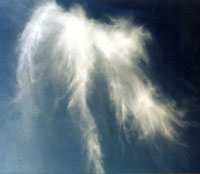Below you will find an alphabetical listing of common icons found in many cemeteries. Each symbol has its own unique meaning. Thus, when carved on headstones, each symbol silently suggests the life story of the people the symbol comes to represent.
The Anchor
As an early Christian symbol, the anchor alludes to St. Clement who is often depicted with an anchor and fish (Wikipedia). On occasion, between the 18th and 19th century, this symbol may have represented someone who has a seafaring profession (Leimer). This symbol may also denote hope (Anon).
The Ankh
Although the Ankh has been around since the Egyptians; this symbol would not have been popular in colonial times. It stands as a symbol of reincarnation, peace, prosperity, and eternal life.
The Arrow
The arrow can suggest martyrdom, were like qualities, or mortality.
Baseball/Basketball
Found on headstones slightly over a decade old, these symbols apparently represent the hobbies that the deceased participated in at one time. Other common symbols representing the deceased’s hobbies exist in cemetery art as well.
Bible
The Bible denotes wisdom (Weeden). It may often represent the divine word of God or personal accomplishments (Anon).
The Caduceus
The Caduceus depicts the symbol of a physician or the healer. The symbol itself consists two snakes entwined around a staff and the symbol stand as an emblem for healers (Merriam-Webster's).
The Dove
The dove is common to Christian decor and symbolizes peace and the Holy Ghost or Spirit. It also signifies the human soul (Anon).
The Dragon
A dragon is the symbol of Imperial Power, the universe, and chaos (GAzis-Sax).
The Eye of God
This symbol appears significantly similar to the 16th century painting, "The Eye of God.” It signifies that God is universal, and sees all, including sins.
The Firemen Emblem
The hose and ladder emblems can often be found on headstones representing individuals that were at one time part of the Fire Department.
Celtic Cross
The knot work on a Celtic Cross is a pagan symbol. The intertwining knots symbolize eternity (Weeden). In our era, the Celtic Cross may represent someone of Irish descent. It is interesting to note that each cemetery surveyed displayed at least one Celtic Cross.
The Crescent Moon
The crescent moon may represent virginity (Weeden). It may also suggest rebirth, and victory (Anon).
The Cross
The cross is a symbol of Christian faith. Thus, this is an extremely common symbol among local cemeteries.
The Crown
The Crown was popular in 18th century New England as a symbol of righteousness (Leimer).
Hand-Pointing Upward
Such a symbol signifies the hand of righteousness (Weeden). It also suggests the pathway or ascension and the elevated realms of heaven.
Hands-Holding
This symbol is common among married couples; indicating marriage, or farewell (Reid).
Hands-Praying
Also a common Christian symbol; the symbol indicates prayers and hopes for attaining life after death.
Hand-Shaking
This symbol differs from the marriage symbol, in that the sleeves denote male and female in the latter. This symbol suggests loyalty and friendship even after death (Reid).
Horse
This symbol may simply denote the deceased's love of horses however, to some that may mean a reference to Saints Martin, Maurice, and Victor, all signifying horseback riding (Anon).
Hourglass
An hourglass, depicted without wings, is a symbol of passing time or Father Time (Anon).
The Hummingbird
This icon may be depicting the deceased's affinity for hummingbirds. Yet, viewed as an animal totem, this bird represents the notion of wisdom, joy, and happiness (Evridge).
IHS
There seems to be a bit of confusion regarding the symbol: Some view it as the Greek symbol for Jesus, Savior of Men and thus sometimes it is viewed as in hoc salus which literally means" there is safety in this" or “in this safety” (Weeden). IHS is sometimes translated as Iesus Hominum Salvator, which means “Jesus, Man, Savior or the Saver of Men.” In other instances, IHS is sometimes translated as In Hoc Signo, which translates as “In This Sign, Ye Will Conquer.
Lilies
A Lily is representative of purity and resurrection because of its white color (kewebshop). In Christian art, the Lily is a symbol associated with the Virgin Mary, as well as the Immaculate Conception.
Leaves (Ivy)
Ivy signifies regeneration, immortality, friendship, and faithfulness (Leimer).
Masonic Symbols
One common Masonic symbol that looks like a pentagram with various symbols, is the icon associated with The Order of the Eastern Star. Another common symbol is that of a compass and square and is the symbol for masons, which stands for faith and reason. The "G" located in the middle of the Masonic symbol stands for God (Hawkins).
Pine Cones
This icon suggests a full, long life with children (Hawkins). Pine cones have many seeds in them, which makes it the ideal symbol for fertility and regeneration, or live after death and immortality achieved through one's children.
The Rose
The Rose signifies completion, perfection, and achievement. In Christian Art, the Rose is symbolic of grace and compassion or love. An eight-pedaled rose signifies regeneration (Leimer). The Rose is also a pagan symbol associated with the Goddess.
The Ship
The ship may be an icon that suggests the deceased's fascination with such. It also indicates the Christian faith and that the ship of faith can carry one through the world, as well as safely into the afterlife (Anon).
The Star
This icon suggests the spirit. For someone of pagan beliefs, it may suggest the four cardinal directions and Akasha; the symbol of all the elements and the spirit (Hawkins). As a Christian insignia, it comes to mean the tale of the birth of Christ.
The Sunset
The Sunset represents death, rebirth, and the promise of everlasting life. In art, the sun is a symbol associated with Christ, and the sunset can represent the ending of one’s life and the entry of an individual into the Kingdom of Heaven. Sunsets are also associated with the cardinal direction of the West and are therefore associated with endings. In some pagan belief systems, the sunset is associated with the Summerlands.
Wheat
The wheat icon suggests time and the divine harvest. It also suggests that we "reap what we sow" and that we will return to the divine harvester (Weeden).
The Willow Tree
The Willow Tree is German in origin, and represents sorrow: especially the weeping willow (Leimer).
Winged Angel
Winged figures indicate the flight of the soul (Hardy). Angels also represent the higher realm, a higher state of existence or consciousness, and can be a symbol representing guardianship or protection.
The Wreath
The Wreath symbolizes the victory of a good life and therefore, victory over death. It also suggests the circle of eternity (Hardy).
The Urn
The Urn stands as an icon of death; ashes of the deceased who have been cremated are often stored in urns. They are sometimes seen alone, or with willow trees and drapes: drapes suggest the final curtain of life (Hardy). Since the Urn is a vessel, it can also represent to act of returning to the Goddess, or the womb of reincarnation.
Woman with Anchor
A woman with an anchor is the Masonic symbol of hope (Hawkins).





























